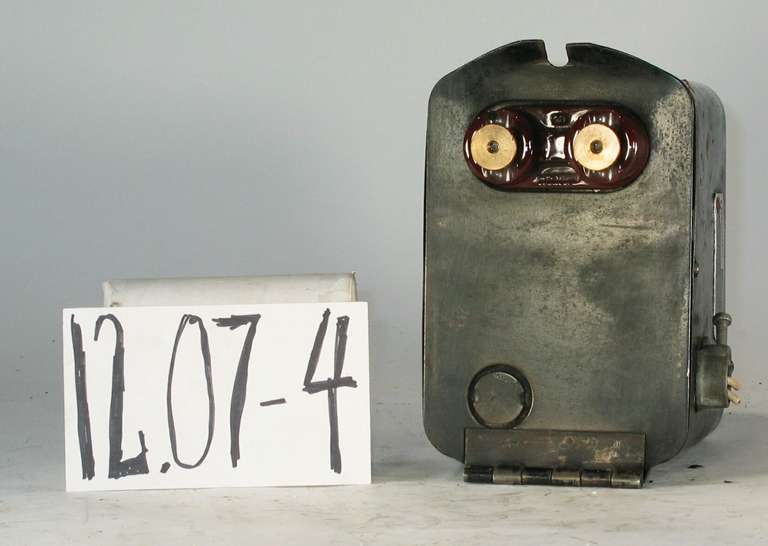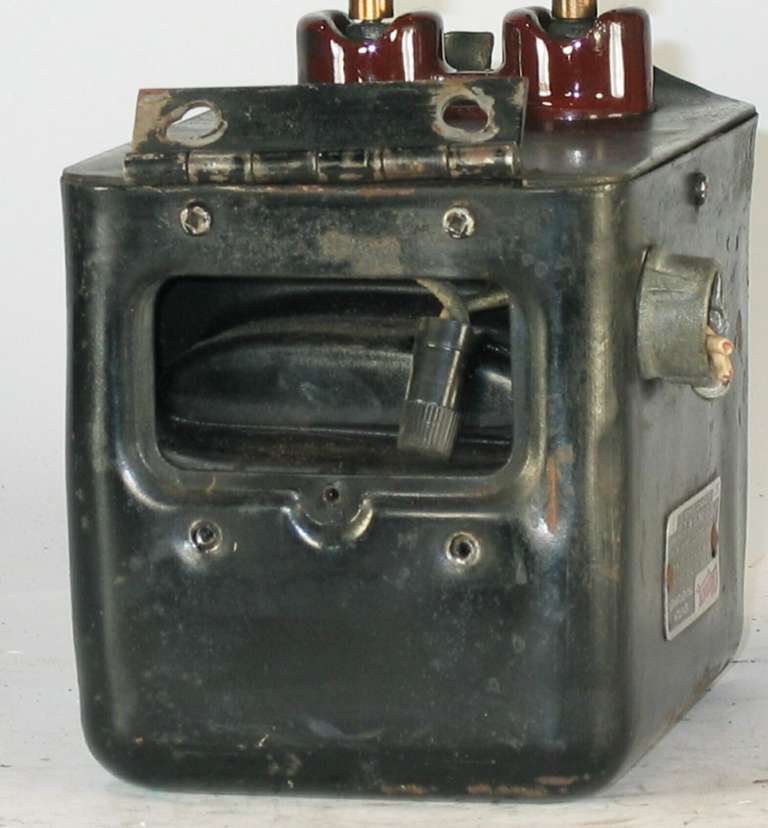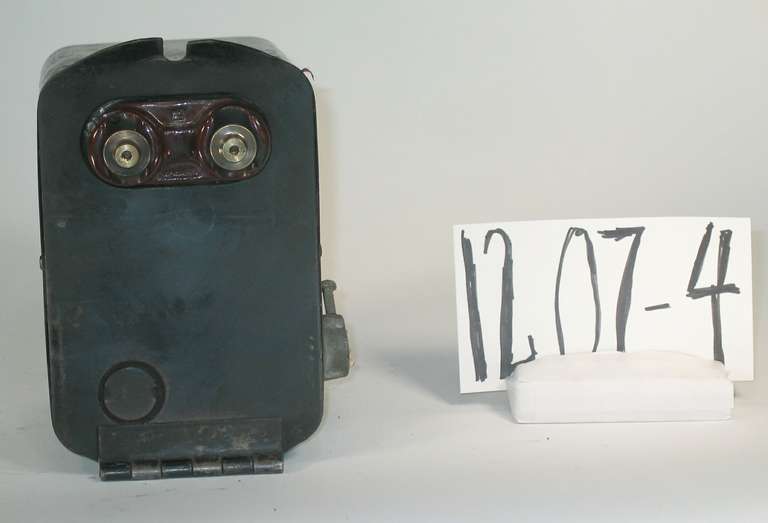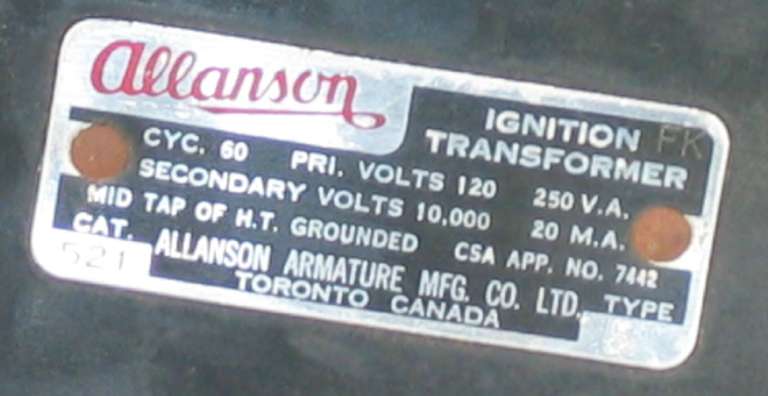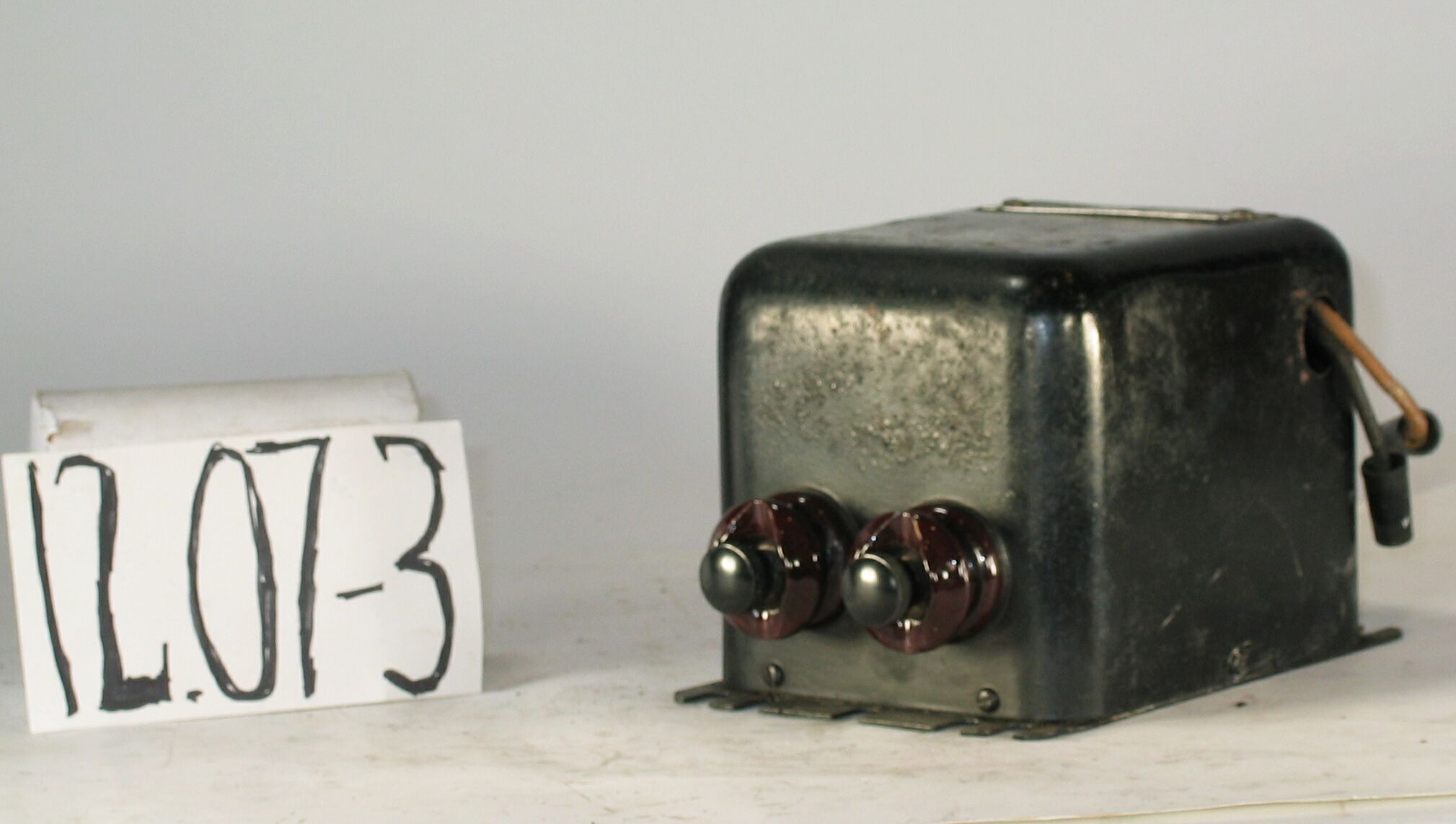12.07-4: Allanson 1964 10,000 Volt, Electric Spark, Ignition Transformer

| HHCC Accession No. 2006.134 | HHCC Classification Code: 12.07-4 |
|---|
Description:
A 10,000 volt, 60 cycle spark, ignition transformer, in ferro-magnetic, steel case in gloss black enamel, with long radius corners, reminiscent of the Art Deco style. Equipped with hinged base-plate and enclosed high tension insulators with adjustable brass pressure contacts and built in junction box, it stands as an historic example of the immense diversity and inventiveness of the Canadian oil heat industry during its years of post W.W.II rapid growth, Allison 1964.
Group:
12.07 Pressure Atomizing Oil Burner Equipment and Systems - Ignition Devices
Make:
Allanson
Manufacturer:
Allanson Armature Mfg Co. Ltd, Toronto
Model:
Cat No. 521, type 5
Serial No.:
Size:
8 x 5 x 5 in. h
Weight:
12 lbs.
Circa:
1964
Rating:
Exhibit, education, and research quality, illustrating the engineering and design Canadian ignition transformers in the post W.W.II, ‘hay day’ of the Canadian oil heat industry
Patent Date/Number:
Provenance:
From York County (York Region) Ontario, once a rich agricultural hinterlands, attracting early settlement in the last years of the 18th century. Located on the north slopes of the Oak Ridges Moraine, within 20 miles of Toronto, the County would also attract early ex-urban development, to be come a wealthy market place for the emerging household and consumer technologies of the early and mid 20th century.
This artifact was discovered in the 1950’s in the used stock of T. H. Oliver, Refrigeration and Electric Sales and Service, Aurora, Ontario, an early worker in the field of agricultural, industrial and consumer technology.
Type and Design:
10,000 volt output, 60 cycle, 110 volts, 20 mil amps. ignition transformer, Ferro-magnetic, steel case, in gloss black enamel, Chrome plated, name plate with Allanson logo styled in black and red Art Deco inspired, long radius. rounded corners Built in junction box hinged base-plate and enclosed high tension insulators with adjustable brass pressure contacts
Construction:
Material:
Special Features:
Original wire connector and cable stubs, illustrating electrical trade practices of the times Art Deco inspired, long radius. rounded corners
Accessories:
Capacities:
Performance Characteristics:
Operation:
Control and Regulation:
Targeted Market Segment:
Consumer Acceptance:
Merchandising:
Market Price:
Technological Significance:
Early high voltage ignition transformers were built in non-ferro magnetic, brass enclosures [See ID# 255 and 256], considered necessary to isolate the enclosure from the electro magnetic circuit. Subsequent engineering studies confirmed the appropriate use of magnetic steel shells, as seen here - a cost saving feature for the manufacturer.
By the 1960’s the toe crushing weight of early ignition transformers [See ID# 255 and 256] had been reduced by 50%, due to advances in engineering design, the use of new inorganic dielectric, insulating materials able to with stand high voltages and surges, as well as as a consequence of frequency standardization [25 to 60 cycle]
Industrial Significance:
The Canadian automatic oil heating industry was expanding rapidly in the 1960’s. The Allanson, Armature Mfg. Co., having made its name in the manufacture electric armatures for the automotive industry, for use in generators and starters would see in the heating industry opportunities for horizontal expansion, making use of its core skills ‘ electrical coil winding.
By the 1960’s the Canadian automatic oil heating industry was into supplying a major after-market, for parts and upgraded equipment. This ignition transformer designed with a hinged base and enclosed high tension connections stands as an example of the range of configurations needed in transformers to meet the diverse engineering and design requirements of the period The increasingly wide range of different physical configurations, as well as different technologies appearing on the Canadian oil heating market by the 1960’s, demonstrated the immense inventiveness characterizing the Canadian automatic oil heating industry of the times. As a result, Canadian ignition transformer manufactures were called upon to adapt their designs to many different configurations, in order to meet the needs of original equipment manufacturers, as well as the diversity of forms required to economically service the after-market [See also ID# 258].
Much of the credibility of the Canadian oil heat industry would rest on its ability to service the after-market promptly, efficiently, and at a cost homeowners could afford. Motors, high voltage ignition transformer and electrodes, as well as high pressure oil atomizing nozzles and oil pumps were all casualties of normal ware and tear, often short lived, often breaking down as a result of prolonged periods of cold Canadian winter weather. A substantial service industry in towns and cities across the country would develop by the 1960’s, with the challenge of maintaining a stock of replacement parts in the many configurations required for emergency, ‘no-heat’ service.
The smoothly rounded, long radius corners, giving this device a distinctly modern Art Deco look, is a marker of the advanced, production manufacturing methods of the 1960’s
Socio-economic Significance:
Socio-cultural Significance:
Donor:
G. Leslie Oliver, The T. H. Oliver HVACR Collection
